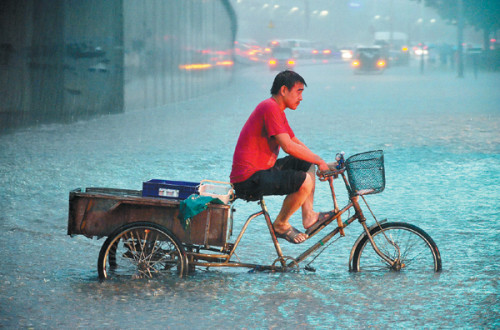
Xu Dajiang has learned to tread lightly on his daily walk to work. He says he has reason to becautious. In mid-August, a giant hole opened up in the middle of Liaoyang Street, a road heregularly travels in Harbin, swallowing four people. An elderly lady and an 8-year-old girl werekilled on the spot. "It could happen to anybody," said the 30-year-old food-quality inspector.
"Now I pay special attention when I see that a road is being repaired. My wife refused to leavethe house for two weeks, fearing she would suddenly disappear into the earth. She still takesdetours to avoid the places that had the cave-ins," he added.
The collapse in August devastated Harbin, a city in Heilongjiang province famous for its exoticRussian-style buildings and winter festivals. Yet, the accident is just one in a series of tragediesthat have struck in urban areas nationwide.
From sinkholes, to flooding caused by antiquated and underdeveloped drainage systems, tofalling glass curtain walls: China's cities have become dangerous places to live, residents say.
Four people were killed and nine injured by sinkholes across the country last month. Nine suchincidents occurred in Harbin alone over a period of 20 days. A Beijing woman died from burnsto 99 percent of her body when she fell through a sidewalk into scalding water on April 8.
Systems undermined
Police say they are still investigating the fatal cave-in on Liaoyang Street. Experts and thepublic, however, are already pointing fingers at poor urban planning and shoddy undergroundconstruction, and many people have taken to the Internet to vent their fears and anger.
"Unbelievable. People just vanished on the street," wrote a blogger on Sina Weibo, a Twitter-like website, on Sept 25. "I'll go to Harbin for a business trip tomorrow. I hope there are nocave-ins."
Another posted, "Please hold your friends' hands firmly (in the street) because it's a case of'now you see them, now you don't'."
Zhao Shuang, who lives near Liaoyang Street, told China Daily the road has frequently beendug up and repaired over the past five years, either to lay or repair cables and gas pipes. "Whycan't they do all of these things at once?" he asked. "It's extremely inconvenient for usresidents."
In a recent essay, Lei Haiying, director of the Geological Environment Institute in Beijing, saidthe frequent cave-ins indicate metropolises are witnessing a surface stability crisis.
In every square kilometer, a city will have an average of 25 km of utility pipelines for water,sewage, gas, cable television and telecommunications, he wrote, adding that construction andmaintenance is more often than not covered by a range of agencies.
Although many cities have established early warning and emergency response systems, Leisaid they are not very professional. Instead of investigating accidents after they occur andrepairing the damage, at huge cost, the goal should be to eliminate the hidden danger, headded.
"Various pipes of different functions are buried underground, running either parallel orintersecting each other," said Li Hongchang, an associate professor at Beijing Jiao TongUniversity's School of Economics and Management. "What often happens is one pipe has aproblem and then affects others around it, making accidents harder to investigate and repair."

Copyright ©1999-2011 Chinanews.com. All rights reserved.
Reproduction in whole or in part without permission is prohibited.